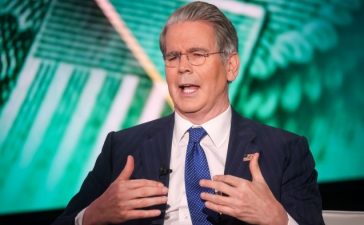The People’s Bank of China slashed interest rates on one-year loans and eased rules on purchases of second homes. The government also issued cash handouts and floated new subsidies for some jobless graduates, while the Politburo vowed to boost fiscal spending to arrest a decline in property prices.
Here are some of the charts that appeared on Bloomberg this week on the latest developments in the global economy, markets and geopolitics:
Asia
 Bloomberg
BloombergA booming market reaction to the policy blitz suggests that the central bank has bought the Chinese economy some precious time. Yet economists believe this is just a down payment if President Xi Jinping is going to pull the roughly $18 trillion economy out of a protracted slump marked by a property market blowout, consumer price weakness and rising global trade tensions.
 Bloomberg
BloombergChina’s central bank lowered the interest rate charged on its one-year policy loans by the most on record, kicking off a sweeping program to revive confidence. The People’s Bank of China cut the rate of the medium-term lending facility to 2% from 2.3%, the biggest reduction since the bank began using the monetary tool to guide market interest rates in 2016.
 Bloomberg
BloombergIndian gold demand looks set for a strong few months as a cut to the import tax and what’s likely to be a buoyant festival and wedding season drive purchases in the world’s second-biggest consumer of the precious metal.
US
 Bloomberg
BloombergThe Federal Reserve’s preferred measure of underlying US inflation and household spending rose modestly in August, underscoring a cooling economy. On a three-month annualized basis, the core personal consumption expenditures price index rose 2.1%, in line with the central bank’s target.
 Bloomberg
BloombergThe US economy bounced back from the pandemic in stronger shape than previously estimated, spurred mainly by bigger consumer-driven growth fueled by robust incomes. The Bureau of Economic Analysis’ comprehensive annual update also showed gross domestic income was revised higher into the first half of this year, which will help support household spending.
 Bloomberg
Bloomberg
With prices down 19% from a peak in 2022, the commercial-property market is starting to come to life. In part, that’s because lenders and owners want to cut their losses and make new investments now that the Fed’s first rate cut in four years is bringing some clarity on where valuations stand.
Europe
 Bloomberg
Bloomberg
The Swiss National Bank cut borrowing costs by a quarter point at a third straight meeting and warned of more to come if needed in its attempt to contain the strength of the franc. With one of the world’s lowest rates, the central bank has limited scope to keep reducing it in any extended confrontation with the foreign-exchange market.
 Bloomberg
Bloomberg
Inflation in France and Spain plunged below 2%, fueling predictions by investors and economists that the European Central Bank will speed up the pace of interest-rate cuts.Emerging Markets
 Bloomberg
BloombergMexico reduced borrowing costs for a second straight meeting Thursday as inflation readings are easing faster than expected and the economy heads for a third year of slower growth. Banxico officials expect that the inflationary environment will allow further reference rate adjustments.
Zambia’s economy will probably grow at its fastest pace in 13 years in 2025 as it bounces back from the worst drought in more than a century.
 Bloomberg
BloombergWorld

Australia kept interest rates unchanged, while Sweden’s Riksbank cut borrowing costs and raised the possibility of a bigger step in coming months. Hungary, Switzerland, the Czech Republic and Guatemala lowered rates, while Morocco held steady. Nigeria surprised with a half-point hike to quell inflation, support its currency and attract investments.Israel stepped up its heaviest air attacks on Hezbollah targets in Lebanon since 2006 after shooting down the first missile ever fired by the militant group at Tel Aviv. The US, Europe and Arab states are striving to calm the escalating fighting and prevent an Israeli ground offensive on Lebanon, which would likely entail large human and economic costs. Such a scenario could spiral into a region-wide war that risks dragging Washington and Tehran into direct conflict.

China launched an intercontinental ballistic missile into the Pacific Ocean in what appeared to be its first such public test in some four decades, a move likely to rattle the US as it seeks to sway world leaders at a meeting of the United Nations General Assembly.










